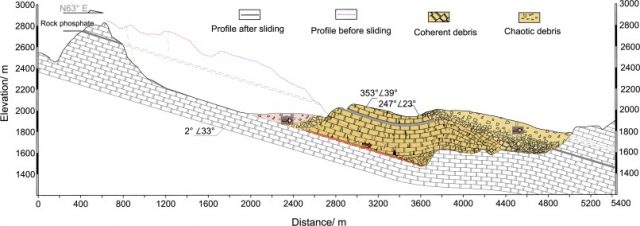18 February 2019
The giant Daguangbao landslide: superheated steam and hot carbon dioxide
Posted by Dave Petley
The giant Daguangbao landslide: superheated steam and hot carbon dioxide
It has long been known that extremely large landslides are able to travel surprisingly large distances – a phenomenon sometimes known as hyper-mobility – which implies that there must be very low levels of friction operating at the base of slide. Numerous methods have been proposed to account for this behaviour, but trying to gain evidence to support them or refute them is challenging.
The largest non-volcanic, terrestrial rockslide in recent years was the huge Daguangbao landslide, triggered by the 2008 Wenchuan earthquake. This is a true giant, with a volume of just over a cubic kilometre, which moved over a distance of about 3 km, as shown in the Google Earth image below:-

Google Earth image of the Dagunagbao landslide. The label marks the crown of the rear scarp of the landslide. The bare rock in the source area is also clear, as is the huge debris deposit.
.
The mechanisms of this complex event, and in particular the processes that occurred in the basal region during its movement, are extensively explored in a new paper just published in the journal Earth and Planetary Science Letters (Hu et al. 2019). The cross section from the paper, shown below, illustrates the extraordinary scale of the landslide:-

The geological cross section of the Daguangbao landslide. Diagram from Hu et al. (2019).
.
The statistics of this landslide are remarkable – for example, the debris in the deposit area is, in places, 500 m thick. This landslide would undoubtedly have traveled a great deal further had the topography allowed.
Hu et al. (2019) used a rotary shear machine to explore the processes operating at the base of the landslide as it moved. Samples of the basal dolomite were sheared at rates similar to those in the slide, and the strength was measured. The samples were then chemically and physically analysed to see if changes had occurred as a result of the deformation. During shearing,the resistance of the basal surface was found to drop as the rate of shearing increased. This is a neat self-reinforcing mechanism, which has been seen before. Basically, the earthquake initiated sliding and, as the landslide accelerated the friction in the base dropped, allowing the slide to accelerate further, which in turn further reduced the friction. That such a mechanism was operating is no great surprise.
But what is interesting here is that two processes were operating simultaneously to generate this very low friction. In both cases these are associated the very high temperatures caused by the shearing under such high pressure conditions. These were found to exceed 800°C, at which point carbon dioxide started to be released by the shear zone rocks as they decomposed under the high temperatures. This carbon dioxide coated the shear surface in a supercritical fluid (and there would have been superheated steam present too), which in effect increased the pore fluid pressure, reducing the friction.
Analysis of the rocks after the experiments found evidence for the decomposition of the dolomite rocks (described above), but also of dynamic recrystallization, which provides the second mechanism. This dynamic recrystallization formed a very thin layer on the shear surface, just o.1 mm thick, whose viscous resistance was found to be very low. As such, this dynamically recrystallized layer would have generated very low frictional resistance.
So, in the case of the Daguangbao landslide, two process operating in tandem generated the rapid drop in friction that gave this huge mass of rock the ability to travel at high speeds. Such mechanisms can only operate in very thick slides, and thus do not explain the hyper-mobility seen in other cases.
But this study shows that the behaviour of a 2 billion tonne landslide might have been controlled by a layer that is just 0.1 mm thick, which seems remarkable.
Reference
Hu,W., Huang, R., McSaveney, M., Yao, L., Xu, Q., Feng, M. and Zhang, X. 2019. Superheated steam, hot CO2 and dynamic recrystallization from frictional heat jointly lubricated a giant landslide: Field and experimental evidence. Earth and Planetary Science Letters, 510, 85-93. https://doi.org/10.1016/j.epsl.2019.01.005.


 Dave Petley is the Vice-Chancellor of the University of Hull in the United Kingdom. His blog provides commentary and analysis of landslide events occurring worldwide, including the landslides themselves, latest research, and conferences and meetings.
Dave Petley is the Vice-Chancellor of the University of Hull in the United Kingdom. His blog provides commentary and analysis of landslide events occurring worldwide, including the landslides themselves, latest research, and conferences and meetings.